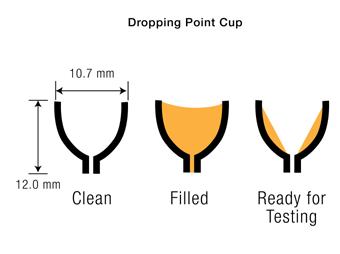
32 minute read
The Dropping Point Test – Time to Drop It?
Dr Gareth Fish, PhD CLS CLGS The Lubrizol Corporation Wickliffe, Ohio, USA
Abstract
As originally approved in 1940, the ASTM D566 (ISO 2176) dropping point test was used to give an indication of the higher temperature performance of a grease. A historic rule of thumb suggested that the upper operating temperature of a grease was approximately two-thirds of the dropping point. The ASTM D2265 dropping point test, using an aluminum block heater instead of an oil bath, was introduced in the 1960s. When it was standardized, a fudge factor was introduced to adjust the observed dropping points from ASTM D2265 to match the results from ASTM D566. A 1968 ASTM research report into dropping point test methods recommended deleting the ASTM D566 method, but it is still here and in service today. In 1991, Labude presented an NLGI paper that suggested that this fudge factor was no longer valid. In the present study, reviewing the data and greases tested indicated that the greases tested in 1967 bore little or no relation to those in use today. In 2008, Coe spoke out against using the dropping point test as a means of defining the upper operating temperature of grease. The publication of ISO 12924:2010 retained the dropping point test as an indication of upper operating temperature for greases at 60C (≥ 90C dropping point) and at 80C (≥ 130C dropping point). Above this temperature, the dropping point only has to be reported, and the DIN 51821 FE9 test is used as the arbiter. This paper will argue that the dropping point test should be retired from service as it has ceased to have any meaning in the real world. Nevertheless, it is anticipated that the ASTM D2265 dropping point test will be around and in service for many more years. This paper will also explore attempts by formulators to get high dropping point values through additives and thickener technologies.
Background
Long before the American Society for Testing Materials (now called ASTM International) approved the first standardized method for dropping point testing in 1940 (1), there were many other techniques for determining the maximum usable temperature of lubricating greases. In 1909, Gillette (2) published a paper on analytical methods and friction testing of lubricating greases. In this paper, he acknowledged that determining the melting temperatures of greases was not standardized and everyone used different methods. One test he reviewed, developed in Germany by Ubbelohde (3), used an 80 to 100 mm long capillary tube with a 4 mm inner bore diameter, graduated at 10 and 50 mm from one end. Test grease was forced into the capillary tube at the 10 mm graduated marker end up to the line. A second tube was then prepared similarly, and both capillary tubes were tied to a calibrated thermometer with the bulb adjacent to the grease. This assembly was then inserted into a beaker of water to the 50 mm marker. The water was heated at a controlled rate of about 2C per minute until the grease softened to a point that the 50 mm head of water pressure forced the grease to rise up the capillary tube. The melting point was taken as the average of the two temperatures when the grease was forced upwards. Archbutt and Deeley (4) identified several other methods of determining the melting temperature of lubricating greases, including some crude methods that were the forerunners of today’s ASTM
D566 (ISO 2176). One method, described as being especially applicable to hard greases with high melting points, was to place a 2 mm cube of grease on a quantity of mercury in a 25 mL crucible with a thermometer bulb inserted into the mercury. The crucible was heated on a hot plate until the melting temperature was recorded on the thermometer. Another reported test method for the determination of the melting point of fats and lubricating greases (undated and unreferenced but prior to 1889) was that of Pohl. Archbutt and Deeley (4) suggested that the method was originally developed to determine the melting temperature of fats. In Pohl’s method, lubricating grease or the fat of interest was melted, applied to the sides of the bulb of a thermometer, and then allowed to completely cool off. The thermometer with its layer of grease was then suspended inside a test tube by a cork with a vent hole. The test tube was then heated until the grease started to flow and form a drop at the bottom of the thermometer bulb. This temperature was described as the drop point of the fat or the grease. This method did not work with cup greases as the pre-melting significantly altered the grease’s behavior. Cup greases, which covered many variants of water-stabilized calcium soap greases, are now referred to as hydrated calcium soap greases in the latest NLGI Grease Guide (5). A variant on this was Stock’s method (6), published in 1889, that used a small glass tube into which a thermometer with a small amount of test grease on the tip of the bulb was inserted and held in place by a rubber sleeve. The gap between the side of thermometer bulb and the tube wall was 1.6 mm. The thermometer with the grease was held at about 12 mm from the bottom of the tube. This assembly was inserted into a larger test tube. This was in turn immersed into a beaker containing oil or water, depending on the expected melting temperature of the grease. The fluid was heated with a Bunsen burner at a controlled rate until a bead of molten grease flowed to the bottom the test tube. This was recorded as the melting or dropping point of the grease. One variant of the test method was to draw a thread of grease from the thermometer bulb and then heat it until the thread melted or was drawn back to the bulk of the test sample. Another method coated the thermometer bulb in grease, inserted it suspended into a test tube which was then heated in oil at a rate of 3C per minute. As the temperature increased, the grease softened, and a drop fell to the bottom of the test tube. The temperature at which this happened was recorded as the melting or dropping point of the grease. In his 1927 textbook “Lubricating Greases”, Klemgard (7) discussed the need to determine the upper usable temperature of cup greases for use in bearing applications. The melting temperature and the consistency of the grease at the upper operating temperature of the bearing were identified as key characteristics. Making sure that the grease was properly applied was also a significant factor in grease consumption. Klemgard noted that cup greases did not have a well-defined melting point as observed for pure and crystalline materials. When he heated several different cup grease samples, they softened (increased in cone penetration) as the temperature rose to a maximum of 93C. In some instances, the test greases completely liquified before they reached the top temperature. He also noted that some other different cup greases lost water through evaporation and hardened with heating as the gel dried out. Klemgard noted that the factors influencing melting behavior were the type and viscosity of base oil, the fat to lime ratio, and the amount of water present.
The Current Dropping Point Test Method
Today, some of these historic methods seem almost like alchemy, and many would be frowned upon or forbidden in the current safety-conscious world. Today, ASTM D566 is carried out by carefully positioning a thermometer so that the bulb is within the central zone of the dropping point cup, but not actually touching the grease. The grease cup is filled with an air-free quantity of grease. Then, using a standardized metal rod, most of the grease is removed, leaving only a thin layer of grease on the walls of the cup (1). This is illustrated in Figure1.
Figure 1 Dropping point cup
The prepared cup is then inserted into the test tube, and this is assembled into the beaker with two thermometers, ready for testing. This is shown in Figures 2 and 3. The heater is switched on and manually controlled to heat the sample at a rate between 4and 7C/min until the bath reaches a temperature of approximately 17C below the expected dropping point of the grease. At this point, the rate of heating is reduced so that the temperature difference between the test tube and the oil bath is maintained between 1 and 2C. As the temperature increases, one of three things typically happens: 1) material may gradually protrude through the orifice of the grease cup, form a droplet at the orifice and then drop; 2) the grease completely melts and pours rapidly through the orifice; or 3) as in the case of aluminum complex greases, the grease forms a string from the bottom of the orifice which slowly extends downwards. When a drop of material or the string hits the bottom of the inside of the test tube, the temperatures on the two thermometers are noted. The average of these two temperatures is calculated and reported as the dropping point of the grease.
Figure 2 Dropping point tube assembly

Figure 3 ASTM D566 apparatus assembled

A skilled operator can control the heating rate very well within the required parameters. The maximum and minimum specified heating rates are shown in Figure 4. The maximum and minimum specified heating rates are shown in Figure 4.
Figure 4 ASTM D566 temperature ramp rates

The dropping point in this method is defined as “a numerical value assigned to a grease composition representing the temperature at which the first drop of material falls from the test cup; that temperature being the average of the thermometer readings of the sample and bath.” For simple soap thickened greases, the dropping point is an approximate measure of the melting point of the soap. The dropping point itself does not have any bearing on the performance of the grease as it is an in vitro static test. There was a historical rule of thumb that suggested that the upper operating temperature of a conventional soapthickened grease is approximately 2/3 of the dropping point.
Running the dropping point test takes a considerable amount of time, and the results can be operator sensitive. In 1964, the ASTM D02.G Sub-Committee on Lubricating Greases approved a new method for the determination of the dropping point of greases (8). ASTM D2265 “Standard Test Method for Dropping Point of Lubricating Grease Over Wide Temperature Range” was significantly different from the ASTM D566 test method. The new method used the same test tube assembly as the ASTM D566, but the heating method and rate were radically different. The heating was accomplished via an aluminum block that had been allowed to equilibrate at a defined temperature. Originally, the fixed block temperatures were defined as 250, 450 and 650F (121, 232 and 343C). Subsequently, the maximum allowable block temperature of 343C was removed and the intermediate levels of 288 and 316C were added. The maximum dropping point temperature that could be determined at that block setting were also fixed. The information is listed in Table 1.
Table 1 Block temperatures and maximum determinable dropping points
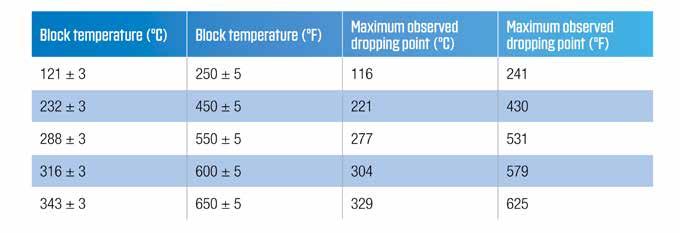
In 1966, McCarthy (9) presented data from work that was carried out under the auspices of the ASTM Lubricating Grease Sub-Committee. The report was in two parts. The first part was a check on the precision and bias of ASTM D566. The second part re-introduced the newly approved ASTM D2265 and compared the dropping points as determined this method and by the traditional ASTM D566. It was noted that the ASTM D566 dropping point test was being used to give an indication of the upper operating temperature of the grease despite the scope of the method stating that the dropping point was not an indicator of the performance of the grease. It was also stated that its primary purpose was a grease quality control tool that could indicate if the grease thickener had been correctly manufactured. The inter-laboratory (round robin) study (ILS) was intended to verify the precision statement for the ASTM D566 test method. Nine greases were tested by eight different laboratories, giving fifty-six degrees of freedom. It should be noted that eight of the nine greases had conventional soaps and the ninth had a high-melting-point calcium complex thickener. Although not stated, it is assumed that all the greases were mineral oil based. The original paper had all measurements reported in degree Fahrenheit. Table 2 has the average data from the laboratories and samples converted into degree Celsius.
Table 2 Test data from the original 1967 inter-laboratory study converted to degree Celsius
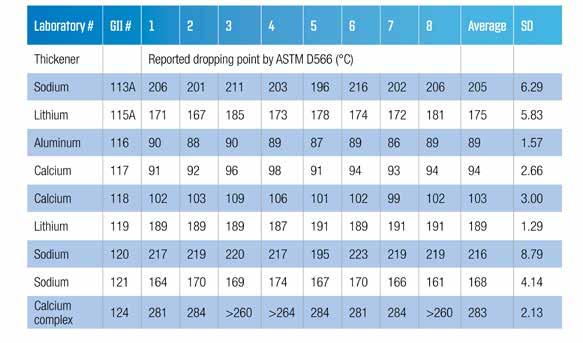
This re-introduction of the new dropping point test method described the efforts that had taken place to try to get a method that was much easier to use than the traditional oil bath method approved. Several attempts were described to get good agreement between the two methods and introduced the concept of adjusting the observed dropping point so that it matched the original ASTM D566. Repeatability and reproducibility were defined based on the maximum allowable dropping point for each block temperature. The data presented showed that the higher the dropping point, the greater the scatter. The original data have been converted to degrees Celsius, and the observed dropping points back calculated from the reported values and the defined block temperature. Review of the data showed that, even with the adjustment factor, the data did not always agree. This set of data is presented in Table 3.
Table 3 Comparison of ASTM D566 and ASTM D2265 dropping point data
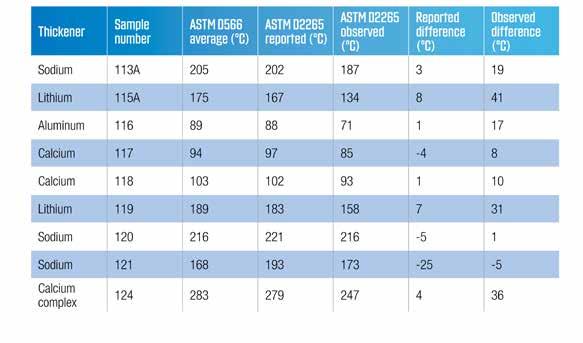
For the two hydrated calcium greases, the data showed only slight differences between the two methods. Two of the three sodium greases also gave good agreement, but the third one gave much lower dropping values than would be expected for a sodium grease. The biggest concern was that there were significant differences between the dropping point as determined by ASTM D566 and the observed dropping point. Even applying the correction factor, the dropping points by the two methods were not fully in alignment. At the 1991 NLGI Annual Meeting, Labude (10) presented a review of the two dropping point test methods. The different heating rates for the various block temperatures were compared. The results showed that when the block was set to 343C, the time to reach 150C was around 75 seconds, and at 232C, around 150 seconds. As the 343C temperature is no longer used, the time to reach temperatures using the three main temperatures (232, 288, and 316C) was re-measured, and the graph shown in Figure 5.
Figure 5 Thermometer response at the three block temperatures Looking at a conventional lithium grease, the block should properly be set to 232C, although Labude (10) noted that many laboratories that took part in a dropping point ILS on the ASTM D2265 kept their block set to 343C. Based on data presented for complex greases, the dropping point was always much higher when using the 343C block compared to the 288C block. It was pointed out that using the fixed temperature block was not in keeping with the intent of the method. Labude also pointed out that when testing complex greases, the adjustment factor (that was introduced into the ASTM D2265 to get it to match the ASTM D566) did not work with high temperature complex soap thickened greases. Later in the 1990s, the Institute of Petroleum (IP, now the Energy Institute, EI) introduced a new automated dropping point tester (11). The equipment consisted of a programmable temperature controller and furnace into which a steel dropping point cup holder was inserted. The internal dimensions of the cup were the same as the standard ASTM cup, and it was filled in the same way. Heating was controlled and typically ran at ramp rate of 10C/min up to 20C below the dropping point when it switched down to 1C/min until a drop was detected by an electric eye and recorded automatically, without the need to continually monitor the test. This method worked well for conventional soap thickened greases with dropping points < 220C, but above that temperature the
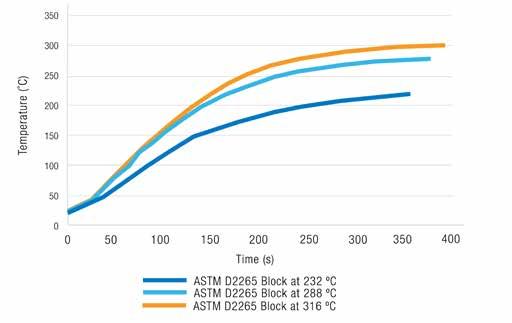
results were very scattered. In a study carried out in 1995, a lithium soap thickened mineral oil grease was tested ten times with the IP 396 and ten times with the IP 132 (technically equivalent to ASTM D566 and ISO 2176) by the same operator in the same laboratory. The traditional dropping point IP 132 tests took four days to complete, whilst the IP 396 tests were completed within one day. The spread of results for the IP 132 test method was from 191to 199C. The mean was determined to be 195C. For the IP 396 test, five results of 194C and five results of 195C with a mean of 195C were obtained. Further work showed that for anhydrous calcium and lithium soap greases, the typical results for these two thickener types were consistent between the two methods, but running the IP 396 gave quicker results. Later, a polyurea grease with a dropping point around 260C was tested. The results showed a huge amount of scatter with dropping points from 200 to > 300C and, in some cases, the dropping point was not detected, even though grease material was found in the bottom of the sample holder. Looking at the temperature ramp rates for the three standardized test methods, ASTM D566 is the slowest, taking up to 60 min to reach 200C, with ASTM D2265 reaching the same temperature after 4 min with the block set to 232C, and only 125 sec with the block at 316C. The IP 396 temperature ramp rate is closer to that of the ASTM D566, 35 min to reach 200C. These data are shown in Figure 6.
Figure 6 Comparison of dropping point temperature ramp rates.
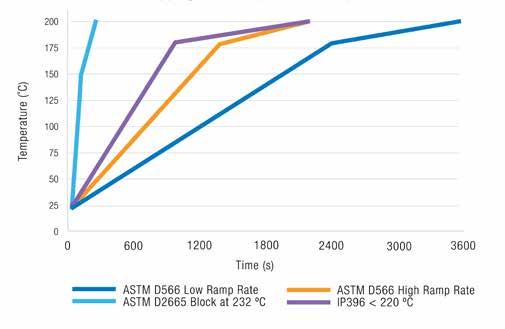
One of the challenges with the IP 396 apparatus is that when running greases with high dropping point temperatures, or greases that smoke when heated, the electric eye drop detection system gets fogged. This can result in the failure to detect the drop. The detector needs to be cleaned every few tests to ensure that this does not happen. The other issue is that degradation products of the tested greases can build up inside the furnace. This makes it difficult to insert and extract the sample holder. The apparatus needs to be stripped down periodically and the lacquers and deposits need to be physically removed with fine abrasive paper. More recently, a new dropping point test was introduced. It was intended to replace the apparatus for the IP 396 test. One advantage of the new unit is that it does not need a separate controller to define the temperature ramp rate. The other feature of the new apparatus is that the equipment videos the test so that if the drop is missed, the video can be re-run to the point that the dropping point occurred, and the temperature noted. The new apparatus has two sample holders, allowing that the test to be
run in duplicate in a single determination. The ramp rate is programmable like the IP 396 and can be set to match this IP test conditions or as in the ramp rate of the ASTM D566. Work was carried out to explore the behavior of the new test method, in terms of determining the dropping point and comparing the results with those obtained by the ASTM D2265 test method. A simple lithium soap grease, a lithium complex grease, and a calcium sulfonate gel grease were tested. The data are shown in Table 4.
Table 4 Dropping point data for the new tester compared to that from ASTM D2265.

The lithium soap grease showed similar values for the reported dropping point and when using the other three ramp rates. The calcium sulfonate grease showed no drop with any of the conditions tested. The lithium complex grease was problematic due to the fact that the new equipment gave significantly different data relative to the ASTM D2265 method, including the observed dropping point. Additional testing was run on these three greases and on another lithium complex grease that had an ASTM D2265 dropping point of 250C. The results for the new dropping point test further illustrated issues with higher dropping point greases. When the simple lithium grease was run in duplicate, similar results were obtained. Determinations #1 and #2 were both 198C when the ramp rate was 10C/min. Replicate testing with lower ramp rates as per ASTM D566 gave two results of 193 and 194C. A fresh sample of the lithium complex grease from Table 4 gave results of 276 and 277C when ramped at 10C/min compared to the original determinations at 278C by ASTM D2265, but only between 249 and 265C when run at the slower ASTM D566 ramp rate. The calcium sulfonate grease gave consistently “no drop” readings no matter what ramp rate was employed. When the lithium grease was run as one of the two test samples with either the lithium complex or the calcium sulfonate grease as the other, its dropping point was seemingly unaffected. However, for the second grease the dropping point value was significantly lowered. The original lithium complex dropping point went from originally 275C down to 250C. The second lithium complex grease went from originally 250C down to 233C. The reasons for this lowering of dropping point are under investigation. The other issue was that when the calcium sulfonate grease got hotter than 300C, they started to smoke, and this caused issues with the video taking and seeing the drop form. At this stage, the test method still needs more work before it can be standardized. Another issue is that only a limited number of the new test equipment units are currently in use by the grease industry. A further significant issue is that both the ASTM D566 and ASTM D2265 methods specify the use of mercury-in-glass thermometers, typically ASTM IP 3C that is a 76 mm immersion thermometer capable of operating to 400C with 1C graduations. Based on recent work, it has been attempted to replace these mercury thermometers with liquid alloy containing thermometers. Galinstan™ is an alloy based on gallium. It is still a hazardous material, but it is not as hazardous as mercury. Work
within ASTM D02.G0 Sub-Committee is ongoing, as initial results suggested that the new alloy thermometers did not respond as fast as the current mercury thermometers, and the results appeared to be offset. Other work within the Sub-Committee looked at using platinum resistance thermometers to replace the mercury ones. The results looked comparable, but the glass coated thermometer used along with its reader cost several thousand dollars. Work is ongoing on this topic too. In 2008, Coe (12) spoke out against using the dropping point test as a means of defining the upper operating temperature of grease. He reviewed the specifications of various commercial greases and also carried out testing to see how the suppliers’ claims about the high-temperature properties of their greases compared to how they performed in standard high temperature grease tests. The tests utilized were the DIN 51821 FE9 High Temperature Grease Life, ASTM D3527 Wheel Bearing Grease Life, ASTM D4290 Wheel Bearing Grease Leakage and ASTM D5483 Pressure Differential Scanning Calorimetry (PDSC). In addition, the dropping points of the candidate greases were measured. The data showed that there was no correlation between the dropping points and the high temperature performance of the greases. More importantly, some greases did better than others in certain tests, but worse than other greases in other tests. One particular grease, with the highest dropping point of those tested at 309C, barely passed the FE9 at 140C and the wheel bearing life test at 160C, although its supplier claimed that it would work at temperatures up to 180C. Another supplier claimed that a synthetic lithium complex grease could function up to 232C, but this grease had a dropping point of only 291C. In the PDSC grease test, it performed badly with a life of < 5 min, and the FE9 F 50 life was only 109 h at 140C, but in the wheel bearing grease life test it failed at 280 h. The publication of ISO 12924:2010 (13) retained the dropping point test as an indication of upper operating temperature for greases at 60C (≥ 90C dropping point) and at 80C (≥ 130C dropping point). This use of the dropping point reinforces the historical two thirds rule for greases for conventional soap thickened greases. For greases to be used at above 120C, the dropping point only has to be reported, and the DIN 51821 FE9 test is used as the arbiter of high temperature performance. Based on the data from Coe (12) and Fish et al (14), the reliance on the DIN 51821 FE9 test is misplaced as many greases, including ones for high temperature applications, do poorly in this test, but function satisfactorily in other high temperature tests such as the ASTM D3336 high temperature grease life test. The other major issues with using a bearing test are the time it takes to run the test can be up to several weeks, and the high cost of test rig ownership.
Recommendation
What is clear from the data reviewed above is that in high temperature tests run at or above 120C, a high dropping point does not correlate to good performance in any standardized grease tests. Today, the dropping point test is only useful as a quality control tool. Its only purpose is to ascertain that the thickener has been manufactured properly. A good lithium complex grease should have a dropping point above 260C, indicating that the complexing reaction was properly controlled. After being used for more than 130 years, it is time to discontinue relying upon the dropping point test in grease performance specifications. That having been said, it takes approximately twenty years from formal deletion of a test method to completely removing it from global commerce. In the case of the dropping point test. the time to start this process is now. But in the meantime, grease formulators need to know how to obtain high dropping points. Strategies for enhancing thermal stability and artificially increasing dropping points of a variety of greases will be now be outlined.
Proper Control of Complexing
In the 2014 NLGI Paper, Fish and Hsu (15) looked at ways to improve the making of lithium complex thickeners, and consistently high dropping points could be achieved. It was noted that some
specifications demanded a very high dropping point of > 280C, despite the requirement for grease to perform up to 150C. From this is it clear that many specification writers do not understand that the dropping point test is not an arbiter for high temperature performance but merely a quality control test. It has been noted that some new grease specifications from a bearing manufacturer included FE9 life requirements but did not specify a minimum dropping point. It was noted that making lithium complex greases in a one-step process (16) often resulted in a lower than desired dropping point, but based on other data presented, the grease thickeners seemed to be good. The paper from Fish and Hsu (15) outlined how using an anhydrous lithium hydroxide dispersion to make the thickener was far superior to using lithium hydroxide monohydrate. In a standard two-step complexing process, even when using very high levels of complexing acids, the grease barely achieved the minimum required dropping point of 280C. A further benefit illustrated was that using the anhydrous lithium hydroxide dispersion, much higher dropping points could be achieved in a one-step process. With the lithium hydroxide dispersion, much lower levels of complexing acids were used to achieve the required 280C dropping point. As was previously explained (19), reducing the amount of complexing acid reduces the amount of lithium needed for saponification and saves cost. The comparative data when using azelaic acid as the complexing agent are shown in Table 5. The amount of complexing acid needed is approximately half of the amount needed for the lithium hydroxide monohydrate powder and water, and the amount of lithium used is 17% less. Other data using sebacic acid were presented in a previous paper (15).
Table 5 – High dropping points with a lithium hydroxide dispersion
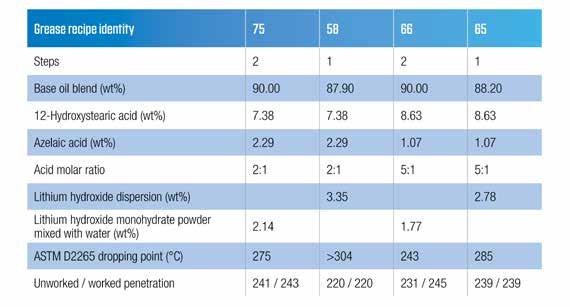
Confusion Between Dropping Point and Thermal Stability
There have been more than 20 papers published in in the last 40 years discussing and outlining strategies to enhance the dropping points of greases. In 2009 (17) and 2010 (18), Lorimor presented data showing that many additives increased the dropping points of grease. In most cases the additives did not increase the thermal stability of the grease, but merely ‘tricked’ the tester into reporting a higher value of dropping point as tested by ASTM D2265. This is a further argument for the illegitimacy of the test method and its current adjustment factor. Lorimor reported (17) that the best dropping point enhancers were boron compounds in which the boron was made available to associate with the thickener molecules and crystals to give them better thermal stability. Many of these additives work in conjunction with zinc dithiophosphates (18).
Table 6 – Borated dropping point enhancer additives in lithium grease
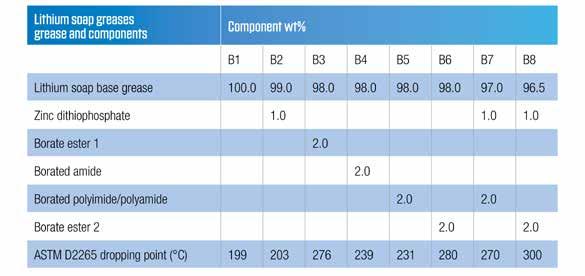
Based on the data presented, borate esters are the most effective way to deliver dropping point enhancement. However, borate esters are not without issues. Hydrolytic stability can be an issue, and they can release alcohols and boric acid, which is an environmental concern in some markets. The alcohols give rise to subjective odors, which may be undesirable. A new odorless borate additive (Borate ester 2) has now been developed that also has enhanced hydrolytic stability and responds similarly to the incorporation of zinc dithiophosphate. Comparative data for this and the other borate compounds are summarized in Table 6. Data presented in 2017 (19), showed that the borate ester 2 could deliver significant thermal stabilization and should not be thought of just as a dropping point enhancer but as better alternative to boric acid as a complexing agent for lithium soap greases.
Calcium Sulfonate Complex Greases
In the paper presented in response to the lithium crisis (19), calcium sulfonate complex greases were proposed as potential alternatives to lithium complex greases. It was noted that when making gels, the dropping point is always above 304C as measured by ASTM D2265. When making calcium sulfonate complex greases, calcium 12-hydroxystearate soap is formed as the co-thickener. The presence of this co-thickener does three things: increases the yield by reducing the amount of calcium sulfonate precursor needed to make the NLGI grade; reduces the load carrying capacity (LCC) of the grease in terms of passing Timken OK load stages and 4-ball weld points and increased 4-ball wear scar diameters; and can reduce the dropping point of the grease. There is no published evidence that the presence of the soap has a negative impact on the thermal stability of the grease. Because of the misconceptions about what the dropping point is, there is the perception that a calcium sulfonate complex with a dropping point of only 280C is inferior to one with a dropping point of > 304C. To boost the LCC, precipitated calcite (CaCO 3 ) is added to the grease. Other ways to boost the LCC are: to add calcium phosphate, either as a powder or formed in situ from the reaction of phosphoric acid and lime; to add acetic acid to form calcium acetate; or to add additives with high (> 35 wt%) sulfur. To boost the dropping point of calcium sulfonate complex greases, one of two solutions is typically employed: adding additional lime and boric acid; or adding an excess of acetic acid and lime. The former produces a calcium salt of boric acid (not calcium borate) whose molecular formula is unclear. The latter produces calcium complex thickener in a similar way to that
seen in a calcium complex thickened grease. In both instances the dropping point of the calcium sulfonate complex grease should be > 304C as measured by ASTM D2265.
Next steps
The way forward is not clear. The ASTM dropping point test methods, as issued, have no long-term future because of their use of mercury in glass thermometers. The replacement of these thermometers with either liquid metal alloy thermometers or by a platinum resistance thermometry system is still under investigation. The equipment to run the current IP396 is no longer manufactured, and its proposed replacement does not give consistent results. Lorimor (18) presented ideas of how the dropping point test may be replaced by differential scanning calorimetry (DSC). The key issue there is that DSC can determine when the thickener system melts, but typically gives no clues as to what the upper operating temperature of a lubricating grease might be. Lorimor (17) and Fish et al (19) presented data to show that rheological methods could potentially be used as a method to determine the upper operating temperature of grease, but again, progress to standardize methods has been slow.
Summary
It is clear from what has been seen and reported over the last 60 years that the originally developed dropping point test, ASTM D566 / ISO 2176, has run its course. The British version, IP 132, has already been made obsolete. The replacement test, ASTM D2265, was approved in 1964 on the basis that its adjustment factor would result in dropping point values similar to those of ASTM D566. The greases tested in that study (9) bore little relation to the greases in mainstream use today. In 1991 (10), it was proposed that the adjustment factor adopted in 1964 (8) was no longer valid and that the test method was in need of revision. As the dropping point test is not likely to be discontinued in the next few years, several strategies have been outlined that would enable grease makers to develop greases to pass higher dropping point requirements. However, in many cases, greases with high dropping points do not give satisfactory high temperature behavior. Additive technologies that both increase the dropping point and increase the high temperature stability of lubricating greases have been outlined in this paper. One key aspect, often overlooked, is that the methods of determining the upper limits on operating conditions of a grease need to be properly defined. Often specification writers select a method that is inappropriate for the application, and this hampers the development of suitable greases.
Conclusion
This paper has presented a discussion on dropping points and dropping point testing, and has concluded that the current methods of determining dropping point by both ASTM D566 / ISO 2176 and ASTM D2265 are unsuitable for lubricating grease in today’s world. Moving forward, other test methods such as rheology and thermal analysis are under study as better methods to determine the upper operating temperatures of grease. Using bearing tests such as the DIN 51821 FE9 is impractical.
Acknowledgements
The author wishes to acknowledge many co-workers and departments within The Lubrizol Corporation for their contribution to this work and colleagues on the ASTM D02 G Lubricating Grease sub-committee. This paper was based on a presentation given by the author at the 86 th Annual NLGI Meeting, June 8-11, 2019 at JW Marriott Resort, Las Vegas, Nevada, USA.
(1)
(2)
(3)
(4)
(5) (6)
(7)
(8)
(9)
(10)
(11)
(12)
(13)
(14)
(15)
(16) ASTM D566 “Test Method for Dropping Point of Lubricating Grease” ASTM International first published 1940 as the T version www.astm.org Gillette, H.W. “Analyses and Friction Tests of Lubricating Greases” J. Ind. & Eng. Chem. (1909) volume 1 (6), pp 351-60 Ubbelohde, L “Handbuch der Chemie und Technologie der Öle und Fette” (1905) published by Berlin p 209 Archbutt, L. and Deeley, R. M., “Lubrication and lubricants: A treatise on the theory and practice of lubrication, and on the nature, properties, and testing of lubricants” 1907 published by C. Griffin and Company Limited, p200 - 203 NLGI Grease Guide 6 th edition 2015. www.ngi.org Stocks method for the melting temperature of grease, Analyst Journal (1889) Volume 14 (xiv) page 2, Royal Society of Chemistry Klemgard, E.N “Lubricating Greases” (1927) published by the Chemical Catalogue Company, Inc., New York. ASTM D2265 “Standard Test Method for Dropping Point of Lubricating Grease Over Wide Temperature Range” ASTM International www.astm.org McCarthy, P.R., “Report of the ASTM technical Committee G on Dropping point methods for Lubricating Grease” Spokesman (1967) Volume 30 (3) pp 76 – 81 Labude, K.M., “Factors Affecting ASTM D2265 Dropping Point results” NLGI Spokesman (1992) Volume 55 (10) pp 391 - 396 IP 396, “Determination of Dropping Point of Lubricating Grease – Automatic Apparatus Method, Energy Institute, (2002), Coe, C.R., “Shouldn’t Grease Upper Operating Temperature Claims Have a Technical Basis”, 75 th NLGI Annual Meeting, Williamsburg, VA June 2008 ISO 12924 “Lubricants, Industrial Oils, Related Products (Class L) – Family X (Greases) – Specification” (2010), ISO, Geneva, Switzerland www.ISO.org Fish, G., Ward Jr, W.C., and Capitosti, S.M. “Grease Additives for High Temperature Bearing Applications” ELGI 26 th Annual Meeting, Dubrovnik, Croatia, April, 2014 Fish, G., and Hsu, C. “Technology to Improve the Grease Making Process” paper #1422, 81 st NLGI Annual Meeting, June, 2014, Palm Beach Gardens, Florida, USA Morgan, D., Kay, J.S. and Coe, C., “Critical Variables in Lithium Complex Grease Manufacturing” 80 th NLGI Annual General Meeting paper #1313, 2013
(17)
(18)
(19)
Lorimor, J.J., “An Investigation into the Use of Boron Ester Additive Systems to Improve the HighTemperature Capability of Lithium 12-Hydroxystearate Soap Thickened Grease”, paper #0912, 76 th NLGI Annual Meeting , Tucson, AZ, June 2009 Lorimor, J.J., “Improving the Heat Resistance of Simple Lithium Soaps Using Borated Additives”, Paper #1003, 77 th NLGI Annual Meeting, Bonita Springs, FL, June 2010 Fish, G., Hsu, C. and Dura, R., “Lubricating Grease Thickeners: How to Navigate your Way through the Lithium Crisis” paper #1713, 84 th NLGI Annual Meeting, June, 2017, Olympic Valley, CA





